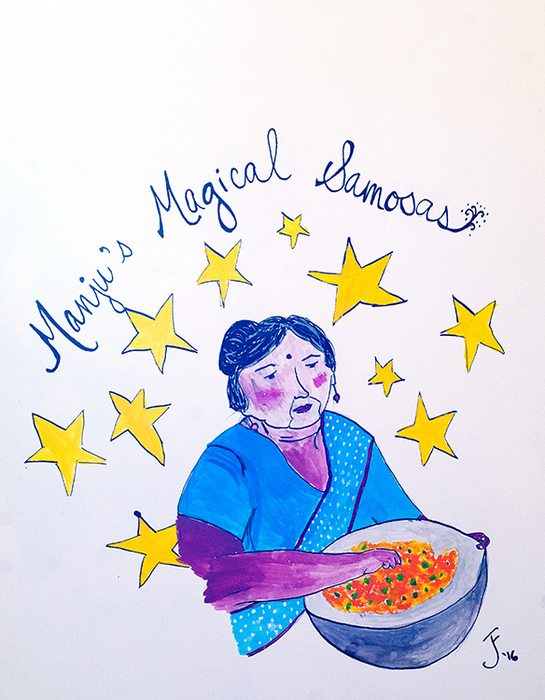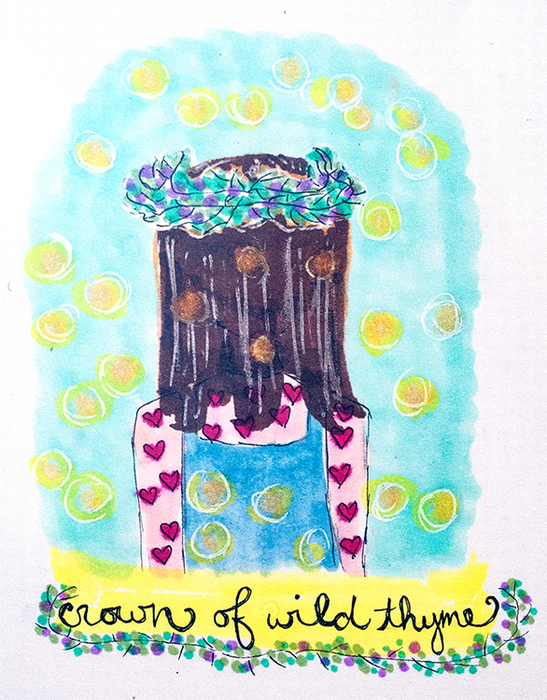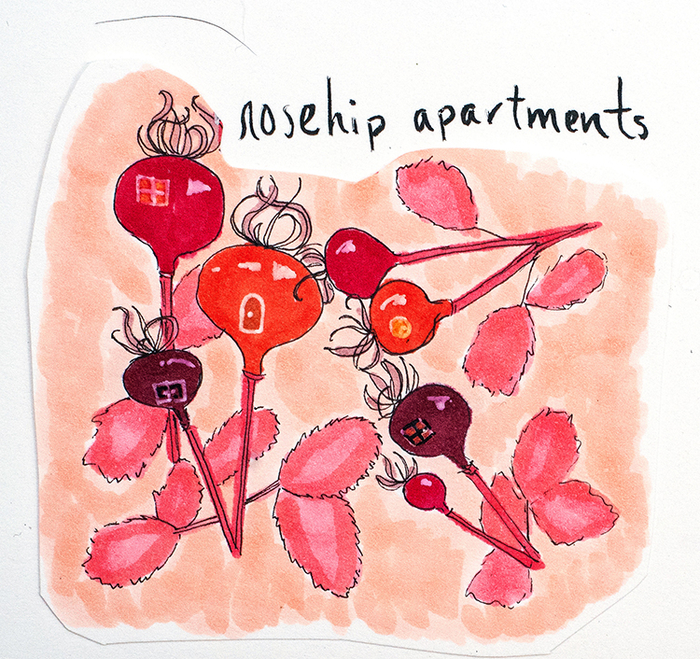Corps de l’article
The room where I draw is full of items that inspire me. Bits of silvery wrapping paper saved from celebrations past; dried flowers and berries tied with twine; feathers and shells collected on many ambles across the bush and beach. The crown jewel in this collection is a rickety bookshelf piled high with all of my favourite, dog-eared picture books I’ve treasured since my childhood. The common thread amongst them is their narratives and illustrations are almost exclusively central to food. There are stories about bears who bake pies and cakes and make jellies for picnics; mice who wear petticoats and bustle about their kitchens, steaming puddings by lantern light; and other storylines dripping with luscious food imagery and a great deal of alliteration: custard creams, pumpkin patches, buttered buns, and the like. My parents thought it was a phase. However, as I grew up, these rich scenes continued to visit me in sumptuous visions, perhaps the result of a “blot of mustard, a crumb of cheese, a fragment of underdone potato”i as one of the pioneers of food description, Charles Dickens, once wrote.
At the turn of the millennia, there was a rapid expansion of televised cooking programs and access to recipes/cooking techniques on the Internet. Soon after, sprawling food-dedicated online communities flourished. A variety of new food imagery began to emerge. Illustration began to inform new food media. Cooking personalities like Nigella Lawson, Jamie Oliver, and others featured playful illustrations of food, food preparation, and other imagery at the beginning of episodes. Print and online magazines presented vivid illustrations to enhance recipes and articles with the same frequency as the previous height of food illustration’s editorial popularity: approximately from 1950 - 1980. And it would be remiss not to mention the release of the animated film, Ratatouille (2007), which impressively merged food-centred narrative and computer illustration together in the limelight of the children’s market. Perhaps most recently, fabric patterns, cards, wrapping paper, calendars, and many other textile and paper art products showcase food, attracting high numbers of consumers. The trend-setting power of food illustration has become increasingly evident in the North American context, with this imagery sweeping through all aspects of retail (i.e., multi-coloured macaroons, deconstructed pineapples, season-driven pumpkin spice everything, among others).
Somewhere in the midst of this emergence, I was thrust back into the warm and safe arms of my childhood bedroom, reading about endearing anthropomorphisms and delicious descriptions all about food, pouring over the rich illustrations as if my eyes were eating the pages themselves. In most children's books, there are pages that entice the reader to pause and to re-examine the illustration in more detail. As noted by Perry Nodelman and Mavis Reimer, the choice of revisited page is different for every reader depending on a number of factors (i.e., preferences, life experience) ii. The pages where I tend to hover are always food-focused and there may be an explanation for this. Carolyn Daniel observes that many readers will pause to appreciate an elaborate meal scene, or “feasting fantasy”iii because of the obvious gustatory satisfaction gained from its descriptions. But as Daniel states, it is also because these rich moments can have lasting impact on the reader. The same could be said of adult consumption of food illustration. Wendy Katz argues:
“the evocation of food and food-related images in children’s literature is the most comprehensive way – for the experience of food is universal and the psychological and social implications rich and generative – of objectifying abstractions necessary for vigorously imaginative work.iv
The more I draw and study the work of other incredible artists and authors, the more I observe connections between the long-standing appeal of food-based children’s book illustration and the rise of food illustration in popular culture. Since launching in 2010, They Draw and Cook, an online hub dedicated to celebrating the work of food illustrators across the globe, has become “the internet's largest collection of illustrated recipes created by artists from around the world”v. Founded by brother and sister illustrator/designers Nate Padavick and Salli S. Swindell, they curate diverse, internationally sourced food illustrations from a wide range of artists. A selection of Canadian food focused illustrators have an impressive presence on the site including, Farida Zamanvi, Ashleigh Greene vii, Cynthia Frenette viii, and Julie Hamilton ix, among others.
Food illustration, whether an apple pie in the pages of a children’s book or on a roll of gift wrap, can bring great comfort to the audience. A food-focused illustration holds our attention and transports us into the piece with every mouth-watering detail. Food is universal. It is a main feature in many cultures; a form of expression; it returns the heart to the home; seduces the mind with description; it can educate with discretion; and most importantly, it can stimulate minds of all ages with an undoubtedly pleasurable response.
Parties annexes
Annexe
Images
Figure 1
Figure 2
Manju’s Magical Samosas: created after spending an afternoon cooking with Manju: Joanna Turner, Winnipeg, April 2016.
Figure 3
Figure 4
Figure 5
Figure 6
Liste des figures
Figure 1
Figure 2
Figure 3
Figure 4
Figure 5
Figure 6







